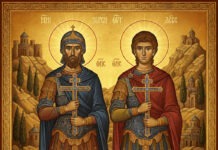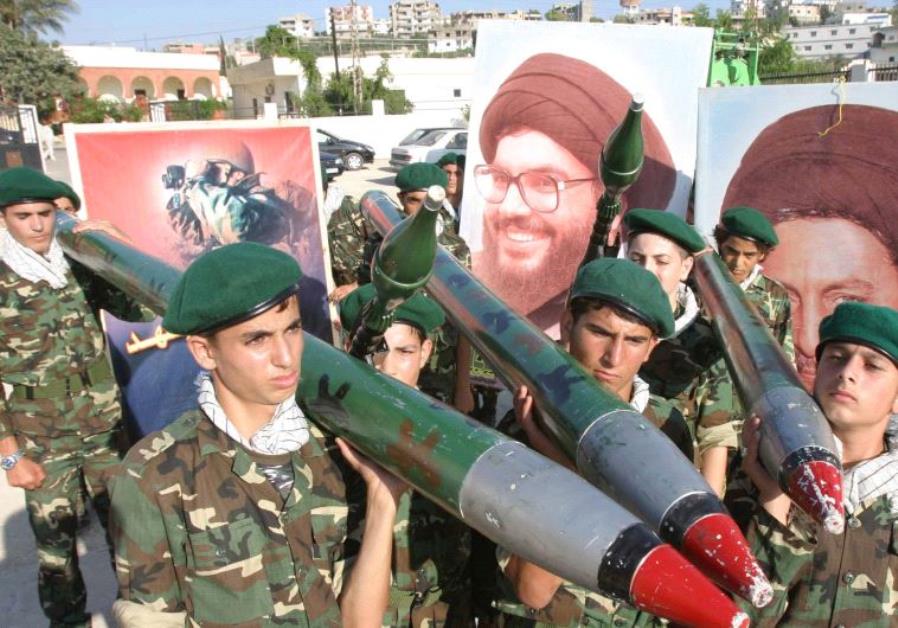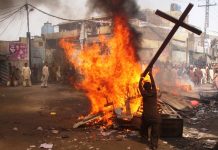Shifts in the Demographic Profile of Hezbollah’s Combat Fatalities: What Do They Mean?
ما هي مدلولات التحولات في الملف الديموغرافي للوفيات في الحروب التي يخوضها حزب الله
Kendall Bianchi/Small Wars Journal/January 02/17
In July 2017, Hezbollah Secretary General Hassan Nasrallah had a message for anyone who still questioned the value of the Party of God’s involvement in Syria. “Ask the people of Hermel,” he advised. “Continue on to the villages around Hermel, to the Bekaa… and to Baalbek… then answer your own question.”[i] His instructions were rhetorical, but they reflected a key internal organizational trend over the past five years. Since Hezbollah’s entry into the war in Syria in 2012, data drawn from death announcements shows that the geographical distribution of martyr hometowns has shifted away from the Beirut area[ii] and increasingly into the areas Nasrallah mentioned: the Baalbek-Hermel Governorate in the northern and central Bekaa valley.[iii]
This change highlights an interesting trend with respect to where–and possibly how–Hezbollah recruits fighters for the war in Syria. Shifts in the geographic distribution of Hezbollah’s martyrs may reflect changes in party recruitment and manpower policies, regional disparities in the motivations of fighters, or some combination of these factors; it may be impossible to surmise which has played a driving role. Regardless, these shifts in the demographic profile of its martyrs from the past to the present day suggest that the political, security, and economic conditions specific to certain regional constituencies have helped ensure a continued supply of motivated recruits and fighters for the war in Syria.
The analysis presented here is based on two datasets from separate time periods. The earlier dataset encompasses the names and hometowns of over 1,200 Hezbollah members killed in Lebanon from 1982 to 2000; the later dataset includes the same information on nearly 900 fighters killed in action between 2013 and mid-2017, mostly in Syria.[iv] For the purposes of this paper, we assume that the demographic profile of Hezbollah’s combat fatalities does not diverge significantly from that of its fighting force as a whole. We cannot assume, however, that the demographic makeup of Hezbollah’s martyrs reflects that of Hezbollah’s entire organizational membership, given the possibility that manpower policies favor recruits from more politically consequential regions and reward them with more desirable jobs. Thus since the geographic distribution of Hezbollah’s martyrs may diverge from that of Hezbollah’s members writ large, this analysis focuses solely on apparent changes in the composition of the group’s fighting force.[v] [vi] [vii]
An analysis of the demographic profile of Hezbollah martyrs poses a number of methodological challenges. For one, the lack of an official census makes it difficult to assess whether the geographical distribution of Hezbollah’s martyrs is proportional to the distribution of the Shia community across Lebanon (although voter registration data may provide a useful benchmark to contextualize the demographic characteristics of Hezbollah’s martyrs; see below). But since this article examines shifts over time in the geographical distribution of martyrs, controlling for the size of the Shia population in each region is only necessary insofar as the distribution of Lebanon’s Shiites may have also shifted over time. Indeed, migration patterns have generally moved away from peripheral areas and toward the Beirut area, possibly biasing the data. But since the distribution of Hezbollah’s martyrs has shifted away from Beirut, the divergent direction of these trends would only make the findings of this article more striking. Moreover, hometowns identified in death announcements generally refer to town of origin, not town of residence; and as a result, migration patterns may ultimately have little or no bearing on the geographic concentration of Hezbollah’s base of support. Of course, possible discrepancies between town of origin and town of residence could also create methodological problems, given that the personal concerns and political attitudes of displaced families may no longer reflect those of the residents of their town of origin. But available information suggests that the majority of martyrs still resided in their town of origin; although residency data may be incomplete, it is worth noting that only about 10% of martyrdom announcements since 2013 indicate a town of residence that diverges from the specified town of origin.[viii]
Geographical Shifts
Hezbollah’s base of support can be broadly divided into the three regions of Lebanon in which the Shia population is concentrated: Beirut and its southern suburbs[ix], southern Lebanon[x], and the Baalbek-Hermel Governorate in the northern and central Bekaa valley. According to Lebanese government data collected and aggregated by the Lebanese Association for Democratic Elections and Lamba Labs, these three regions combined comprise about 90% of Lebanese Shia registered voters in 2017.[xi] Out of the total, 59% originated from southern Lebanon, 21% from Baalbek-Hermel, and 11% from Beirut and the Baabda District (which encompasses Beirut’s southern suburbs of Dahiya) combined.[xii] These figures have remained roughly consistent since 2005–the first year the organization compiled the data. This consistency may be attributed to the fact that Lebanese electoral laws require individuals to vote in their town of origin, derived through the father (or husband, in the case of women married to Lebanese men), and thus does not change when an individual moves to another region.[xiii] Because Hezbollah’s death announcements also identify the martyr’s town of origin, voter registration data may provide an imperfect but useful benchmark against which to gauge the distribution of Hezbollah’s martyrs.[xiv]
The geographical distribution of Hezbollah’s martyrs in the earlier period (1982-2000) corresponds roughly with that of Lebanese Shia registered voters since 2005: approximately 61% of martyrs during this period originated from southern Lebanon, 20% from Baalbek-Hermel, and 9% from Beirut and Dahiya (see Table 1). Since then, however, the distribution of Hezbollah’s martyr base has diverged from that of Shia voters. While southern Lebanon still accounts for about 60% of fighters killed in the later period (2013-2017), the percentage of martyrs hailing from Baalbek-Hermel has jumped from 20% to 28%–an increase of about 40%. This increase has been offset by a sharp decrease in the percentage of martyrs originating from Beirut and its southern suburbs, dwindling from 9% in the earlier period to just 2% in the later period–a reduction of almost 80%. Notably, the city of Beirut produced nearly 60 martyrs between 1982 and 2000, but under 5 between 2013 and mid-2017.
These trends raise an obvious question: what factors have driven the shift in the distribution of martyrs over time? Of course, geographical origin alone does not determine why one man joins Hezbollah’s front lines in Syria while another chooses to remain in Lebanon; motivation is difficult to surmise. There are, however, general conditions present in each region that shape the concerns and motivations of its population. Taken together, these factors likely influence the receptiveness of a given geographical constituency to Hezbollah’s recruiting efforts for the war in Syria. The same is true in an American context, as studies over the years have examined the reasons behind the disproportionate representation of southerners in the ranks of the U.S. military.[xv] Shanea Watkins and James Sherk noted in a 2008 report by the Heritage Foundation that while “demographic characteristics are a poor proxy for the quality of those who serve in the armed forces… they can help to explain which Americans volunteer for military service and why.”[xvi] In the context of Lebanese Hezbollah, examining the prevailing conditions in regions that have experienced shifts in their share of martyrs may help shed light on the factors that have facilitated recruitment specifically for the war in Syria.
The shift in the geographical distribution of martyrs hometowns out of the Beirut area and into the Baalbek-Hermel region likely reflects the rising importance of several overlapping factors in recruiting for the war in Syria: socioeconomic status, security fears, and domestic social tensions.
Socioeconomic Factors
Shifts in the geographic composition of Hezbollah’s martyrs suggests that the group’s fighters in Syria are more likely to be drawn from poorer areas than their predecessors. Since independence, the Lebanese government has focused its development efforts disproportionately on Beirut as an economic center, resulting in the relative marginalization of peripheral regions including the Bekaa valley.[xvii] In 2008, research[xviii] showed that the Baalbek-Hermel region ranked above the national average in both poverty and human deprivation, and the onset of the Syrian war has only exacerbated the situation. In 2016, the UNOCHA reported[xix] that the influx of Syrian refugees had contributed to a population increase of 67% in the Bekaa valley, imposing a significant strain on regional infrastructure as well as the labor market[xx]; poor security conditions, meanwhile, have decimated the tourism sector.[xxi] Thus the shift of Hezbollah’s martyrs from the Beirut area to the Baalbek-Hermel region suggests that by and large, these martyrs originate from lower socioeconomic strata than their predecessors.
In addition to broad regional shifts, micro-level changes in the geographic distribution of Hezbollah’s martyr base also appear to correlate with socioeconomic development. Take, for instance, Hezbollah’s stronghold of Dahiya, south of Beirut. While the majority of Dahiya’s martyrs in the earlier dataset originated from the relatively upscale neighborhood of Ghobeiry, almost all of its martyrs in the later dataset came from poorer areas including Hayy Sollom, Burj al Barajneh, and Haret Hreik. Another possible indicator of the increasing relevance of socioeconomic factors is that Hezbollah’s more recent martyrs hail less often from urban areas than their predecessors did. This change is most obvious in Beirut as described above, but it is also apparent across the country; relatively large cities including Baalbek, Nabatiyeh and Hermel all produce notably fewer martyrs as a portion of their mother district than they did previously. The shift away from cities could indicate that recruits from underdeveloped localities may be more likely to perform military service in Syria. Alternatively, since IDPs living in cities may still list their town of origin as their hometown, the shift may signal that urban Hezbollah fighters in Syria have been drawn increasingly from these IDP populations–which are over-represented among Lebanon’s poor.[xxii] Finally, it is possible that Hezbollah prefers to send men from more peripheral and less politically influential regions to combat units in Syria–rather than sending men from the group’s stronghold on the outskirts of Beirut.
The ostensible increase in the share of martyrs from less developed areas suggests that socioeconomic considerations may play a larger role in mobilizing fighters than they did in the past, since individuals from lower socioeconomic strata are less likely to have economic alternatives outside the party. Recent developments have further limited the availability of economic alternatives to those who do not fight in Syria: As Hanin Ghaddar has noted, rising war budgets have caused the party to focus their domestic service provision more narrowly on fighters and their families rather than the whole community, possibly incentivizing those who require these services to volunteer for military service.[xxiii] A 2015 Daily Beast report indicated, moreover, that some of those who decline to fight in Syria have seen their reservist paychecks and family benefits cut.[xxiv] Combined, these factors may make individuals from poorer, less developed, and more peripheral areas more likely to join Hezbollah–which, under current circumstances, means serving in Syria.
While Hezbollah may simply be benefiting from socio-economic need, one should not discount the possibility that they also intentionally target more marginalized communities to attract recruits for the war in Syria. If this is the case, it would not be the first time the party has demonstrated a shrewd understanding of the relationship between socioeconomic status and a willingness to serve. After the 2006 war with Israel, for instance, the group granted intentionally small one-off payments to fighters and their families. “If we gave them all Range Rovers,” one unnamed official told journalist Nick Blanford regarding the payments, “they wouldn’t want to fight anymore.”[xxv]
Fear in the Bekaa Valley
Security fears resulting from spillover from Syria into Baalbek-Hermel may also help facilitate Hezbollah’s military mobilization efforts. For those living closest to Syria, families and livelihood may be at stake, and thus an uptick in martyrs from towns on or near the border near Qusayr seems like no coincidence.[xxvi] Other localities spread throughout this region also face a tenuous security situation. Conflict mapping[xxvii] across Lebanon has shown that while the Beirut area and the Baalbek-Hermel have experienced comparable numbers of security incidents in the past several years and have both fallen victim to attacks by Sunni jihadists, unrest in the capital is fueled more by “social and legal issues,” while unrest in Baalbek stems frequently from border insecurity and violence by militant groups.[xxviii] Since 2014, Beirut and Dahiya have experienced just over 70 security incidents related to the war in Syria, mostly limited to raids, arrests, and demonstrations; meanwhile, Baalbek-Hermel saw over 500 such disturbances.[xxix] [xxx] As the mapping shows, incidents in Baalbek-Hermel are also more serious in nature, including not only raids and arrests but also shelling of ISIS and Nusra positions, rocket attacks by militant groups, and clashes between Lebanese forces and militants.
The volatile security atmosphere in this region has fostered a climate of fear that may make the population more receptive to Hezbollah recruitment efforts for the war in Syria. A 2015 poll of Lebanese Shiites showed that comparatively fewer residents of the Bekaa Valley (70%) felt safe in their area than residents of the South or Beirut (both over 85%).[xxxi] The source of fear in the Bekaa, moreover, demonstrates support in that region for Hezbollah’s claim that “takfiri” groups in Syria threaten the territorial integrity of Lebanon: nearly 60% of Bekaa Shiites saw takfirism as the most important threat facing their community, compared with only 32% of Beiruti Shiites.[xxxii] Finally, the Bekaa Valley was the only region of the three in which a majority of residents named Hezbollah as the primary security provider in the area[xxxiii]–despite the fact that the Lebanese Armed Forces clash with takfiri groups within Lebanon far more often than Hezbollah does so.[xxxiv] Regional disparities in threat perceptions may thus make the Bekaa Valley particularly ripe for Hezbollah support and recruitment in the present day.
Secretary General Hassan Nasrallah’s rhetoric also seems calculated to stoke the fears of Hezbollah’s base–perhaps for political reasons–which may indirectly benefit Hezbollah recruitment in the Bekaa Valley region. While his speeches make virtually no mention of Syrian refugees, they do make frequent references to “armed men” and “takfiris” who have infiltrated the Baalbek-Hermel region, as well as car bombs and rockets that threaten the population there. “Do we not have a right to intervene to avert the risk of the killing, displacement, rape, and looting of thirty-thousand Lebanese living in the Qusayr region?” Nasrallah asked during a speech in February 2014.[xxxv] In August 2017, Nasrallah addressed ISIS attacks on two Lebanese Christian towns in Baalbek, conjuring up a frightening scenario: “God knows, with these [ISIS fighters] who planned to occupy Ras Baalbek and Al-Qaa, what could have happened in the Bekaa and in the country as a whole.”[xxxvi]
Social Tensions and Sectarianism
One cannot ignore the role that sectarian tensions may play in motivating fighters, given that Hezbollah intervened in Syria under the pretext of defending Shia holy sites. The organization has always recruited largely from Lebanon’s Shia population, but it may be possible to view the role of sectarianism in facilitating mobilization within the context of the two factors discussed above; specifically, socioeconomic frustrations and security fears specific to the Baalbek-Hermel region may help stoke sectarian tensions that benefit Hezbollah’s mobilization efforts.
With regard to the overlap between security concerns and sectarianism, takfiri militants often take cover in the Sunni-majority pockets of the Baalbek district. Their presence there may aggravate Shia fear and mistrust of nearby Sunni communities–propagating Hezbollah’s particular brand of sectarianism, which is not anti-Sunni per se but rather seeks to instigate fear of and hatred for Sunni regional actors that threaten Shia communities or take an anti-Shia line. As for the overlap between socioeconomic frustration and sectarianism, a 2015 poll asked the Lebanese Shia community to name the form of identity that gave them the greatest sense of personal pride.[xxxvii] A breakdown of the results showed that while only about 8% of the wealthiest respondents chose Shia identity, over 30% of the poorest respondents gave the same answer–demonstrating that the extent to which sectarian sentiments influence motivation may correlate with the socioeconomic status of the target population. Additionally, a high concentration of Syrian refugees in the North and the Bekaa has contributed to intense labor market competition in both of those regions. While few Shias inhabit the North, job competition between the largely Sunni refugees and indigenous Shia populations in the Bekaa may cause socioeconomic fears to manifest additionally as sectarian resentment. In sum, the role of sectarianism in incentivizing recruits to volunteer for service in Syria should also be viewed within the context of socio-economic frustrations and security concerns.
The Future of Hezbollah
Whether the trends revealed by the data reflect party policies, recruit motivations, or some combination of both, changes in the demographic profile of Hezbollah’s combat fatalities may have adverse consequences for the organization. For one, the ostensible uptick the number of martyrs from socioeconomically deprived regions may further institutionalize socioeconomic hierarchies within the party, and prompt resentment against perceived or real party policies. Moreover, Hezbollah is unlikely to leave Syria in the foreseeable future, so these casualties will likely continue to mount. And if Hezbollah goes to war with Israel, these hierarchies may result in further inequities in the distribution of casualties among the organization’s supporters. Finally, geographical disparities in threat perception may further divide the organization. A renewed Israeli threat from the southern front would likely draw the attention of residents of the south; but it is possible that residents of Baalbek-Hermel may remain more focused on the proximate takfiri menace.
At present, the shifting geographic distribution of Hezbollah’s martyrs seems to have benefited the group’s ability to wage war in Syria. Whether or not these shifts will bear unintended consequences in the long run, however, remains to be seen.
Table 1 [xxxviii]
* Voting registration dataset only stretches back to 2005.
** As mentioned, Southern Lebanon includes both the South Governorate and the Nabatiyeh Governorate.
*** Although the “Dahiya” suburb of Beirut is administratively attached to the Baabda District of the Mount Lebanon Governorate, for the purposes of this chart it is considered a part of the “Beirut area” category.
End Notes
[i] “Statement of Hassan Nasrallah on television about the course of the Joroud Arsal Battle,” Al Manar, July 27, 2017, http://www.almanar.com.lb/2368221.
[ii] “Beirut area” refers to both Beirut city proper and the group’s stronghold in the city’s southern suburbs, also known as “Ad-Dahiya al-Janoubia” or simply “Dahiya,” technically located in the Baabda District.
[iii] The Bekaa region of Lebanon has been subject to changes in administrative division over the years. Today, the northern and central Bekaa valley is comprised of the Baalbek-Hermel Governorate, which encompasses the districts of Baalbek and Hermel. The Bekaa Valley region also includes the Bekaa Governorate, encompassing the districts of Western Bekaa, Zahle, and Rashaya.
[iv] Death announcements often do not specify the death location of the martyr. Given that the bulk of Hezbollah’s military operations in recent years have taken place in Syria, it is safe to assume that most of its martyrs since 2013 were killed there.
[v] The earlier data (1982-2000) was drawn from short martyr bios on an official Hezbollah website, Moqawama.org; the later data (2013-2017) was collected from martyrdom announcements posted on pro-Hezbollah website Arabipress.org.
[vi] Data from the 2006 war against Israel was not available in sufficient quantity to include it in the dataset.
[vii] In order to account for the under-reporting of casualty data, statistics presented in this paper should not be interpreted as precise measures, but rather suggestive of broad trends. Moreover, errors and inconsistencies in the group’s own reporting may have also contributed to inaccuracies in the figures presented here–although there is no reason to believe that errors and inconsistencies have biased the data in a particular direction.
[viii] Data on town of residence may not be entirely reliable. Indeed, for the earlier period (1982-2000), it is absent. For the later period (2013-2017) it may be incomplete or inconsistent.
[ix] This category refers to the city of Beirut and its southern suburb of Dahiya, the latter of which is administratively attached is to the Baabda District of the Mount Lebanon Governorate.
[x] “Southern Lebanon” refers to the Nabatiyeh and South Lebanon Governorates combined.
[xi] “Registered voters by confession,” Lebanese Elections Data, http://lebanonelectiondata.org/confessions.html.
[xii] Because the Baabda District’s Shia population is concentrated in Dahiya, we can assume that the number of Lebanese Shia in Baabda is approximately equal to the number of Lebanese Shia in Dahiya, although the two figures may not be exactly the same; see Sergey Kondrashov, “Lebanon religious groups distribution,” December 29, 2012, https://commons.wikimedia.org/wiki/File:Lebanon_religious_groups_distribution.jpg.
[xiii] Ziad Abu-Rish, “Municipal Politics in Lebanon,” Middle East Report 46, 280 (Fall 2016), http://www.merip.org/mer/mer280/municipal-politics-lebanon.
[xiv] Of course, the lack of collated electoral data by these NGOs prior to 2005 makes it difficult to measure the distribution of Shia registered voters in the earlier period (1982-2000) against the distribution of Hezbollah’s martyrs during that time. However, given the fact that the distribution of registered voters remained consistent from 2005-2017 and that individuals vote in their town of origin rather than town of residence, it may be reasonable to assume that the distribution of Shia registered voters has not changed significantly over the past few decades.
[xv] See for example: Ann Markusen, Peter Hall, Scott Cambpell, and Sabina Deitrick, The Rise of the Gunbelt: The Military Remapping of Industrial America (New York: Oxford University, 1991); see also Tim Kane, “Who Bears the Burden? Demographic Characteristics of U.S. Military Recruits Before and After 9/11,” Heritage Foundation, November 7, 2005, http://www.heritage.org/defense/report/who-bears-the-burden-demographic-characteristics-us-military-recruits-and-after-911.
[xvi] Shanea Watkins and James Sherk, “Who Serves in the U.S. Military? The Demographics of Enlisted Troops and Officers,” Heritage Foundation, August 21, 2008, http://www.heritage.org/defense/report/who-serves-the-us-military-the-demographics-enlisted-troops-and-officers.
[xvii] Muzna al-Masri, “Between Local Patronage Relationships and Securitization: The Conflict Context in the Bekaa Region,” Lebanon Support, January 2015, https://data2.unhcr.org/en/documents/download/42975
[xviii] Heba Laithy, Khalid Abu-Ismail, and Kamal Hamdan, “Poverty, Growth and Income Distribution in Lebanon,” International Poverty Centre Country Study no. 13 (January 2008), http://www.ipc-undp.org/pub/IPCCountryStudy13.pdf.
[xix] “Bekaa and Baalbek/Hermel Governorates Profile,” UNOCHA, May 2016, https://reliefweb.int/sites/reliefweb.int/files/resources/10052016_Bekaa%20and%20Baalbek-Hermel%20Profile.pdf.
[xx] “Assessment of the Impact of Syrian Refugees in Lebanon and Their Employment Profile,” International Labour Organization, 2014, http://www.ilo.org/wcmsp5/groups/public/—arabstates/—ro-beirut/documents/publication/wcms_240134.pdf.
[xxi] Al-Masri, January 2015.
[xxii] See Kristian Alexander, “Lebanon,” in Encyclopedia of World Poverty, ed. Mehmet Okedon (Sage Publications, 2006), p. 630.
[xxiii] Hanin Ghaddar, “Economic Alternatives Could Help Split Shiites from Hezbollah,” Washington Institute for Near East Policy, October 18, 2016, http://www.washingtoninstitute.org/policy-analysis/view/economic-alternatives-could-help-split-shiites-from-hezbollah.
[xxiv] Jesse Rosenfeld, “Hezbollah Fighters Are Fed Up With Fighting Syria’s War,” Daily Beast, December 30, 2015, https://www.thedailybeast.com/hezbollah-fighters-are-fed-up-with-fighting-syrias-war.
[xxv] Nicholas Blanford, “Joining Hezbollah,” The Cairo Review, Fall 2011, https://www.thecairoreview.com/essays/joining-hezbollah/.
[xxvi] Qusayr was the site of Hezbollah’s first intervention in Syria in 2012.
[xxvii] “Geo-located mapping of conflicts in Lebanon,” The Civil Society Knowledge Center, Lebanon Support, http://civilsociety-centre.org/cap/map1.
[xxviii] “Conflict Analysis Bulletin,” Issue 6, The Civil Society Knowledge Center, Lebanon Support (March 2017), http://civilsociety-centre.org/article/conflict-analysis-bulletin-issue-6-march-2017.
[xxix] To recreate this map, set the parameters to include the years 2014, 2015, 2016, and 2017. “Primary classification of conflict” is equal to “Border conflicts (Syrian border)”. “Caza” is one of Baalbek, Hermel, Beirut, or Baabda. Zoom in on the map to distinguish between incidents in Baabda that occurred within Dahiya from incidents that occurred in other areas of the district. Note that the “border conflicts” variable is defined below the map, and encompasses spillover conflicts like raids and arrests in Syrian camps or demonstrations related to Syria, even if they do not take place close to the Syrian border.
[xxx] As of December 14, 2017.
[xxxi] “15 Questions for the Lebanese Shia Community,” Hayya Bina, July 2015, http://www.shiawatch.com/public/uploads/files/15-Questions-Leba
[xxxii] Ibid. Residents of the south also felt the takfiri threat particularly acutely, at 62%.
[xxxiii] Ibid.
[xxxiv] See conflict mapping.
[xxxv] “Sayyed Nasrallah in Memory of Our Martyred Leaders,” Moqawama.org, February 2014, https://www.moqawama.org/essaydetails.php?eid=30066&cid=142.
[xxxvi] “Sayyed Nasrallah: We Want Our Country as a Free, Independent, Dear and Noble Sovereign,” Moqawama.org, August 2017, https://www.moqawama.org/essaydetails.php?eid=34556&cid=142.
[xxxvii] Lebanese citizenship, Shia identity, and Muslim identity were the three most common answers. See: “15 Questions for the Lebanese Shia Community,” Hayya Bina, July 2015, http://www.shiawatch.com/public/uploads/files/15-Questions-Lebanese-Shia-Community%20%5BShiaWatch%20Alert-38%5D.pdf.
[xxxviii] Data on distribution of registered Shia voters adapted from: “Registered voters by confession,” Lebanese Elections Data, http://lebanonelectiondata.org/confessions.html.
**About the Author Kendall Bianchi
Kendall Bianchi is a research assistant at the Washington Institute for Near East Policy. She previously studied Arabic in Jordan on a NSEP Boren Scholarship and in Morocco on a U.S. Department of State Critical Language Scholarship. Her work has also appeared in Foreign Affairs and the Washington Institute’s Fikra Forum. Follow her on Twitter at @klbianchi1.





















